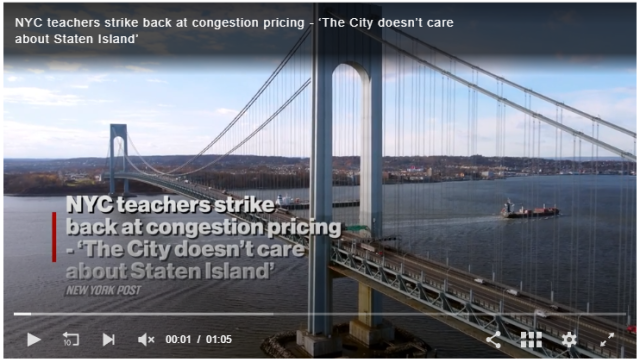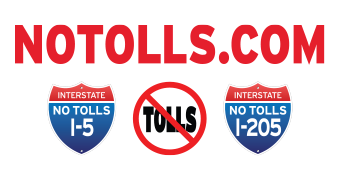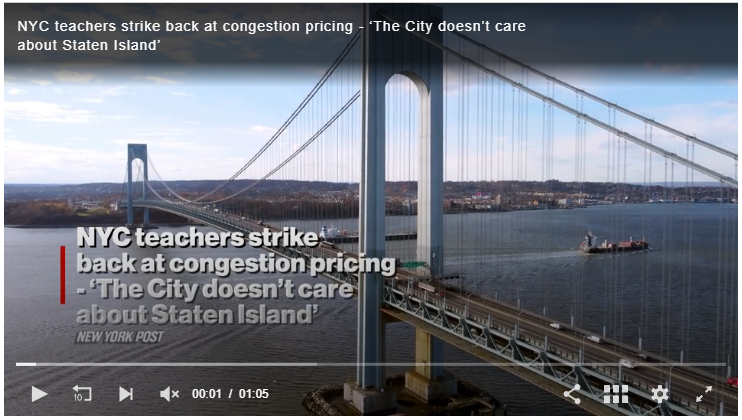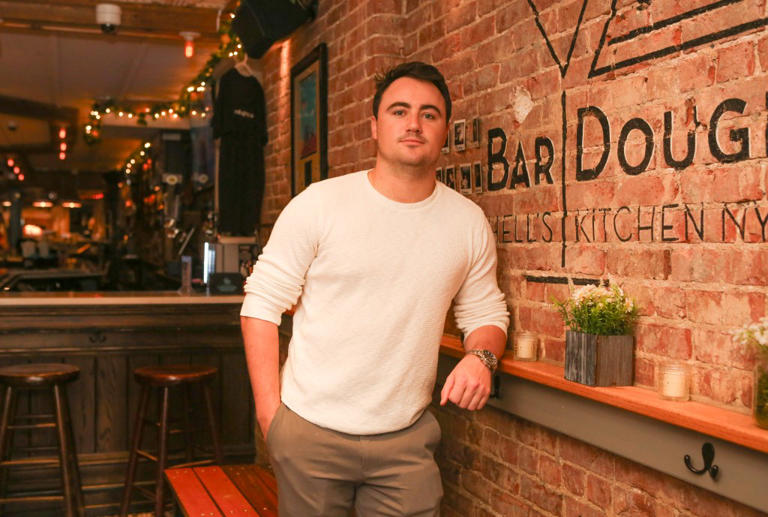Zone tolling reduces business traffic in London as NYC businesses worry
Story by Nolan Hicks, Jack Morphet, NY Post
Feb 11, 2024
Some shops and eateries in central London saw their receipts drop 5% when the British capital rolled out its congestion pricing program — which the Big Apple’s controversial planned $15 daily toll is modeled on.
While the percentage may not seem like much, Manhattan restaurant and store owners said it would be devastating, given their already dangerously thin margins thanks to COVID.
“There’s no one here on Monday, and there’s no one here on Friday,” said Brian Owen, who owns three restaurants in Midtown and one on the Upper West Side. “[Five percent] doesn’t sound like a lot … but we have razor-thin margins.”

(Video here).
London’s troubling decrease in business came as traffic congestion in its tolled zone, which contains the city’s famed theater district and eateries, plunged by far more than expected, or nearly 30%, almost overnight.
While the plummet in traffic may have pleased advocates, it cost businesses whose customer base shrunk and eventually forced officials to trim back the program’s hours.
Manhattan eatery and shop owners said London’s early experience is troubling as they brace for the MTA’s expected launch of its congestion-pricing plan in mid-June.
“Six years ago, [congestion pricing] could have been a great idea, when the economy was growing and thriving, but this seems like it could be the worst time,” Owen said.
“This is going to result in less [traffic], which is less people, which is less business, which is the opposite of what we need right now to recover.”
Elesha Burke, the manager at Tito Murphy’s on West 46th Street in Manhattan, says that if congestion pricing hits businesses in Manhattan as hard as it did for those in London, it could cost her eatery its profit margin. James Messerschmidt
Elesha Burke, who manages Tito Murphy, a Mexican restaurant in the Theater District, agreed that congestion pricing “will have a big impact on our customers.
“Our customers are pre-theatre and post-theatre. If they get charged to come into the city on top of their theatre tickets and parking, they’re probably not going to come to eat, they’re probably going to go straight home,” Burke said.
Under the plan by the Metropolitan Transportation Authority, drivers in Manhattan will be charged once per day if they cross into the Big Apple south of 60th Street or exit the FDR Expressway or West Side Highway and come onto the local avenues and streets.
Murphy Fitzpatrick of another theater-dependent eatery, BarDough, said most restaurants would have a hard time surviving even a 5% hit.
“Our margins have thinned,” Fitzpatrick said. “That’s [a] huge” cut.
Murphy Fitzpatrick, the manager of BarDough on West 46th Street in Manhattan, says the coming toll could have a devastating widespread effect. James Messerschmidt
Brian Owen, owner of the Crave Fish Bar, worries that congestion pricing will eat away at what little profit margin his Midtown eateries still have post-pandemic. Michael Nagle
The Brits’ toll is now £15, or nearly $19.
The London fee initially applied to vehicles entering or being moved in the zone on weekdays between 7 a.m. and 6:30 p.m., but it now ends at 6 p.m. The toll did not previously apply to holidays or weekends, althoughly it has since been expanded to between noon and 6 p.m. on weekends and some holidays.
London officials also trimmed the weekday hours by 30 minutes, ending the toll at 6 p.m., to give local shops and restaurants a boost in the evening hours before the theater curtains rose on the nearby shows.
New York’s program has three big differences:
- The MTA’s proposal would charge the base toll over a longer period: 5 a.m. to 9 p.m. on weekdays and 9 a.m. to 9 p.m. on weekends
- Off-hour access is not free but does get a 75 percent discount, which means a toll of $3.75 for passenger vehicles
- Those who live in the Manhattan tolling zone will not charged unless they drive out of the zone and then re-enter it.
Additionally, those who live in the zone and make less than $60,000 annually will be able to rebate the charges against their income tax. And drivers using the East or Hudson River tunnels during the peak hours will get a $5 discount to help offset the new cost.
Toll readers hang on a gantry over Manhattan’s Second Avenue for vehicles that will enter the planned congestion pricing zone. Michael Nagle
Cabs and for-hire vehicles will be exempted from the charge, though their customers will have to pay a fee that will be tacked onto their fare.
MTA officials have projected the toll will cut traffic inside the Manhattan toll zone by up to 17%.
In London, initial projections suggested it would cut traffic by 10% to 15% within the tolling zone, according to press clippings at the time. In reality, the decrease in traffic doubled those targets, and newspaper accounts from its first days in action include quotes from Londoners in awe of the quiet and bird song.
The story for businesses in the zone — particularly the shops and restaurants — was much less chirpy, as they complained loudly during the early months that the toll took a bite out of their business.
Cars exit the Queensboro Bridge, which is located just above the proposed tolling zone. Michael Nagle
University researchers commissioned by a major department store in the tolling area, John Lewis, found the toll had shaved its revenue by at least 5% and said the finding suggested businesses lining the area’s famed Oxford Street were suffering the same losses.
The decline came even as the percentage of the store’s shoppers using transit rose from 78% to 84%.
Transit authorities in London countered that that the fall-off could have been fueled by a larger economic slowdown over time.
As for New York City, its plan is facing lawsuits filed by New Jersey politicians, labor unions and residents in areas inside and surrounding the toll zone, who argue that the environmental impacts weren’t studied thoroughly enough for the federal government to grant approvals.
Boosters dismiss the claims and point to the review, which is about 4,000 pages long, and argue that the toll will finally put a dent in Manhattan’s crippling congestion while funding needed transit improvements.
Gov. Kathy Hochul, flanked by MTA chairman Janno Lieber (right) and City Transit chief Rich Davey, shows off the MTA’s newest subway train. Matthew McDermott
The MTA recently rolled out a giant list of programs that the toll would help finance, including: extending the Second Avenue subway to East Harlem; buying enough new subway cars for 43 more modern trains on the letter lines; making 28 more subway stations wheelchair accessible and ripping out the century-old signals along the Fulton Street and Sixth Avenue lines to put in a new reliable computerized system.
In response to Post questions about London’s experience with congestion pricing, MTA officials pointed to a 2008 study commissioned by the US Government of London that concluded the larger economy in the congestion zone was boosted by massive declines in traffic.
“Customers, workers and delivery trucks stuck in bumper-to-bumper Manhattan traffic is not good for business,” said the MTA’s policy chief, John McCarthy. “When this program goes live, we’ll follow the numbers and collect data to ensure the region’s economy continues to grow, and will monitor this closely along with small businesses.”
Additional reporting by Griffin Eckstein






